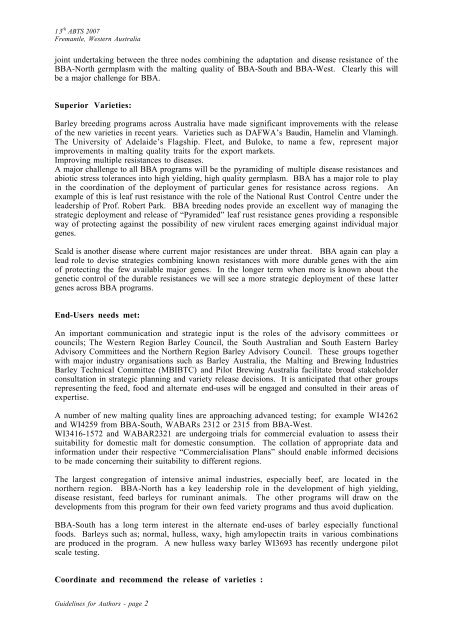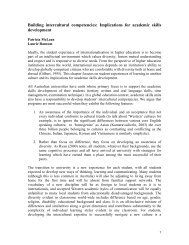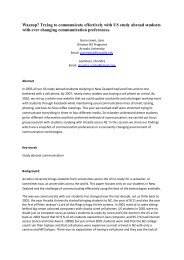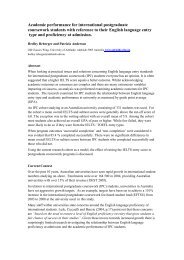Barley Breeding Australia - proceedings.com.au
Barley Breeding Australia - proceedings.com.au
Barley Breeding Australia - proceedings.com.au
Create successful ePaper yourself
Turn your PDF publications into a flip-book with our unique Google optimized e-Paper software.
13 th ABTS 2007<br />
Fremantle, Western <strong>Australia</strong><br />
joint undertaking between the three nodes <strong>com</strong>bining the adaptation and disease resistance of the<br />
BBA-North germplasm with the malting quality of BBA-South and BBA-West. Clearly this will<br />
be a major challenge for BBA.<br />
Superior Varieties:<br />
<strong>Barley</strong> breeding programs across <strong>Australia</strong> have made significant improvements with the release<br />
of the new varieties in recent years. Varieties such as DAFWA’s B<strong>au</strong>din, Hamelin and Vlamingh.<br />
The University of Adelaide’s Flagship. Fleet, and Buloke, to name a few, represent major<br />
improvements in malting quality traits for the export markets.<br />
Improving multiple resistances to diseases.<br />
A major challenge to all BBA programs will be the pyramiding of multiple disease resistances and<br />
abiotic stress tolerances into high yielding, high quality germplasm. BBA has a major role to play<br />
in the coordination of the deployment of particular genes for resistance across regions. An<br />
example of this is leaf rust resistance with the role of the National Rust Control Centre under the<br />
leadership of Prof. Robert Park. BBA breeding nodes provide an excellent way of managing the<br />
strategic deployment and release of “Pyramided” leaf rust resistance genes providing a responsible<br />
way of protecting against the possibility of new virulent races emerging against individual major<br />
genes.<br />
Scald is another disease where current major resistances are under threat. BBA again can play a<br />
lead role to devise strategies <strong>com</strong>bining known resistances with more durable genes with the aim<br />
of protecting the few available major genes. In the longer term when more is known about the<br />
genetic control of the durable resistances we will see a more strategic deployment of these latter<br />
genes across BBA programs.<br />
End-Users needs met:<br />
An important <strong>com</strong>munication and strategic input is the roles of the advisory <strong>com</strong>mittees or<br />
councils; The Western Region <strong>Barley</strong> Council, the South <strong>Australia</strong>n and South Eastern <strong>Barley</strong><br />
Advisory Committees and the Northern Region <strong>Barley</strong> Advisory Council. These groups together<br />
with major industry organisations such as <strong>Barley</strong> <strong>Australia</strong>, the Malting and Brewing Industries<br />
<strong>Barley</strong> Technical Committee (MBIBTC) and Pilot Brewing <strong>Australia</strong> facilitate broad stakeholder<br />
consultation in strategic planning and variety release decisions. It is anticipated that other groups<br />
representing the feed, food and alternate end-uses will be engaged and consulted in their areas of<br />
expertise.<br />
A number of new malting quality lines are approaching advanced testing; for example WI4262<br />
and WI4259 from BBA-South, WABARs 2312 or 2315 from BBA-West.<br />
WI3416-1572 and WABAR2321 are undergoing trials for <strong>com</strong>mercial evaluation to assess their<br />
suitability for domestic malt for domestic consumption. The collation of appropriate data and<br />
information under their respective “Commercialisation Plans” should enable informed decisions<br />
to be made concerning their suitability to different regions.<br />
The largest congregation of intensive animal industries, especially beef, are located in the<br />
northern region. BBA-North has a key leadership role in the development of high yielding,<br />
disease resistant, feed barleys for ruminant animals. The other programs will draw on the<br />
developments from this program for their own feed variety programs and thus avoid duplication.<br />
BBA-South has a long term interest in the alternate end-uses of barley especially functional<br />
foods. <strong>Barley</strong>s such as; normal, hulless, waxy, high amylopectin traits in various <strong>com</strong>binations<br />
are produced in the program. A new hulless waxy barley WI3693 has recently undergone pilot<br />
scale testing.<br />
Coordinate and re<strong>com</strong>mend the release of varieties :<br />
Guidelines for Authors - page 2







